– PPS Grant High School Masonry Analysis
– Pacific Tower Building Assessment
– U.S. Custom House WeWork Renovation
– Queen Anne High School Condominiums
– Washington Park Reservoirs Improvements Project



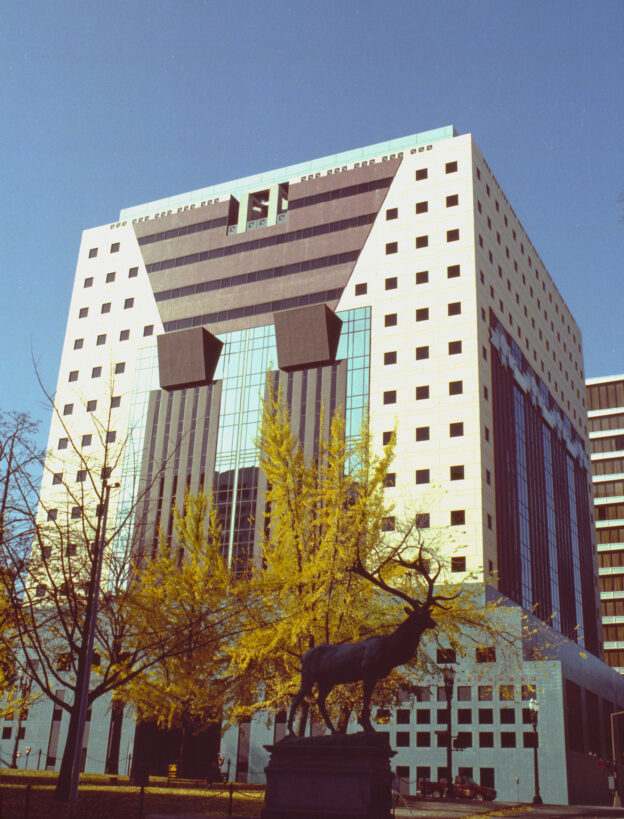
Peter Meijer Architect, PC (PMA) nominated the iconic Portland Public Services building to the National Register of Historic Places. Known universally as the Portland Building, it is one of the most notable works by internationally-known master architect Michael Graves and is widely credited as the design that established Graves’s preeminence in the field.
The Portland Building is significant as one of a handful of high-profile building designs that defined the aesthetic of Post-Modern Classicism in the United States between the mid-1960s and the 1980s. Constructed in 1982, the structure is ground-breaking for its rejection of “universal” Modernist principles in favor of the bold and symbolic color, well-defined volumes, and stylized- and reinterpreted-classical elements such as pilasters, garlands, and keystones.
The building is notable for its regular geometry and fenestration as well as the architect’s use of over-scaled and highly-stylized classical decorative features on the building including a copper statue mounted above the entry, garlands on the north and south facades, and the giant pilasters and keystone elements on the east and west facades. Whether or not one judges the building to be beautiful or even to have fulfilled Graves’s ideas about being humanist in nature, it is undeniably important in the history of American architecture. The building is inextricably linked to the rise of the Post-Modern movement.
Post Modern Architecture: Documentation and Conservation
At the DoCoMoMo US, Modern Matters, conference April 2013 in Sarasota, Florida, DoCoMoMo Oregon presented a debate on the merits of Michael Graves Portland Building and on the larger context of Post Modernism in general. A lively debate at the end of the presentation centered on the merits of DoCoMoMo incorporating Post Modern under the mission of the organization. In general, the support, or lack of support, for an expanded interpretation separated into two distinct viewpoints. The division represented the difference between individuals that look at Post Modernism as a historic event and individuals that still perceive Post Modernism as bad design even if executed within their own practice.
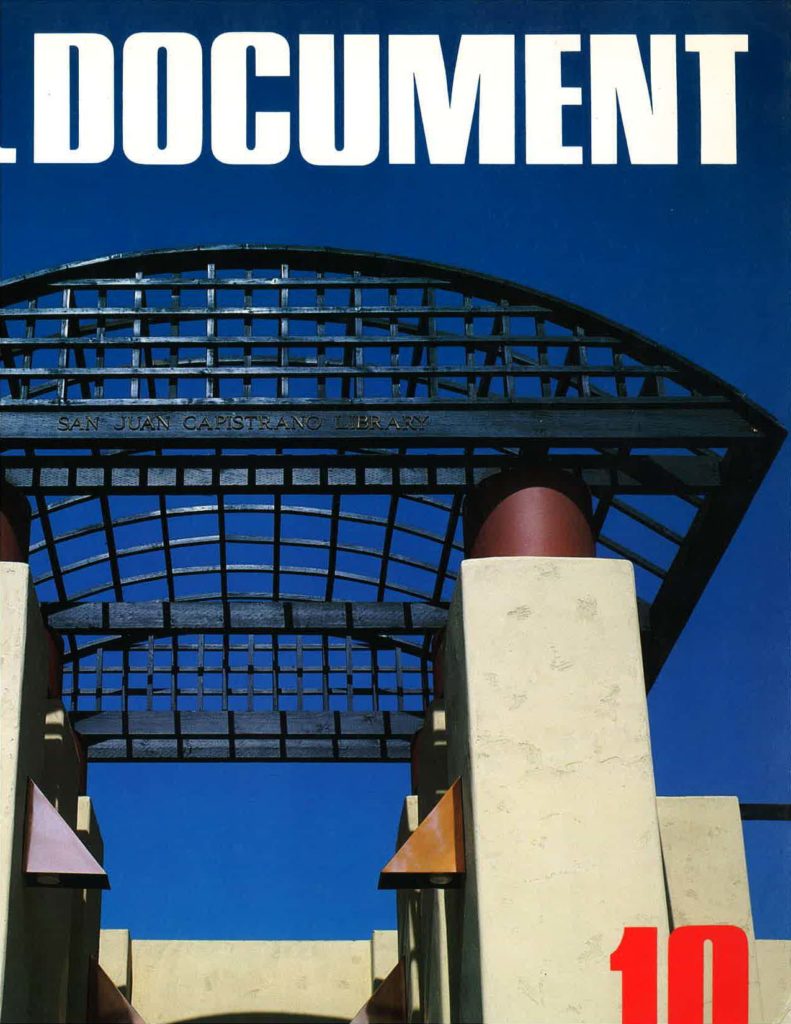
In a seemingly short period of time, a lot has transpired since 2013 regarding the conservation of Post Modernism. After a presentation on Post Modernism: Are You Prepared to Protect It during the Modern Heritage track at the October 2014 Association for Preservation Technology (APT) Conference in Quebec City, the APT Board unanimously supported the need to get ahead of the technical issues associated with preserving Post Modern architecture.
And in December 2015, the Princeton School of Architecture, educational forum for Michael Graves, hosted the Postmodern Procedures Conference. Described in the conference outline, there was a “particular emphasis on methods of documentation and analysis, technical and narrative drawing” related to Postmodern. Post Modern works, buildings, sites, and neighborhoods, as well as art works, are recognized as important design styles deserving conservation and further understanding of construction techniques. And many iconic structures are being negatively modified (Richard Meier, Bronx Development Center, 1977) or lost entirely (James Wines, Sculpture in the Environment (SITE), Best Product Stores, circa 1976). <1>
Post Modern design was broadly practiced in both the United States and internationally. Large and small firms were attracted to the stylistic incorporation of classical western design vocabulary in stark juxtaposition against the plain, unadorned, square box that many argued architecture had become. Post Modern architects, engineers, and material suppliers were pushing new materials and innovative construction technologies as a way to create Post Modern design elements. Continuous innovation in building skins reintroduced porcelain enamel panels, a product brought by Lustron to the building industry during the housing boom following World War II. New skins made from Glass Fibre Resin (GFR) capable of being molded in classical curves and ornamental shapes favored by Post Modern design were created. Innovations in brick technology including large scale brick panels made from a single wythe of masonry to panels whose outer face was only one half inch of masonry, or thin bricks. Improvements in resins created new wood or simulated wood products and adhesives for mounting faux finishes to structural systems. Perhaps one of the more ubiquitous new materials used in the creation of Post Modern architecture was the faux stucco product Dryvit, an Exterior Finish Insulation System (EIFS). Like porcelain enamel panels, EIFS was introduced as insulated wall assemblies as a means to improve energy performance during the world’s energy crisis of the 1970s.
Outside of dramatic assembly failures, particularly within the EIFS industry, that provide insight into Post Modern material and assemblies, much technological information has been relegated to the historical archives. Many Post Modern buildings incorporate systems or components that are neither produced nor currently assembled in similar manners due to improvements in technology and building envelope science. Therefore, the process and method of building restoration, rehabilitation, and/or focused envelope repair could dramatically impact the exterior character of Post Modern structures.
Focusing on one popular building skin material, Alucobond, much in use during the 1980s provides insight into the need for more research and deeper understanding of Post Modern assemblies and how to conserve and protect these systems.
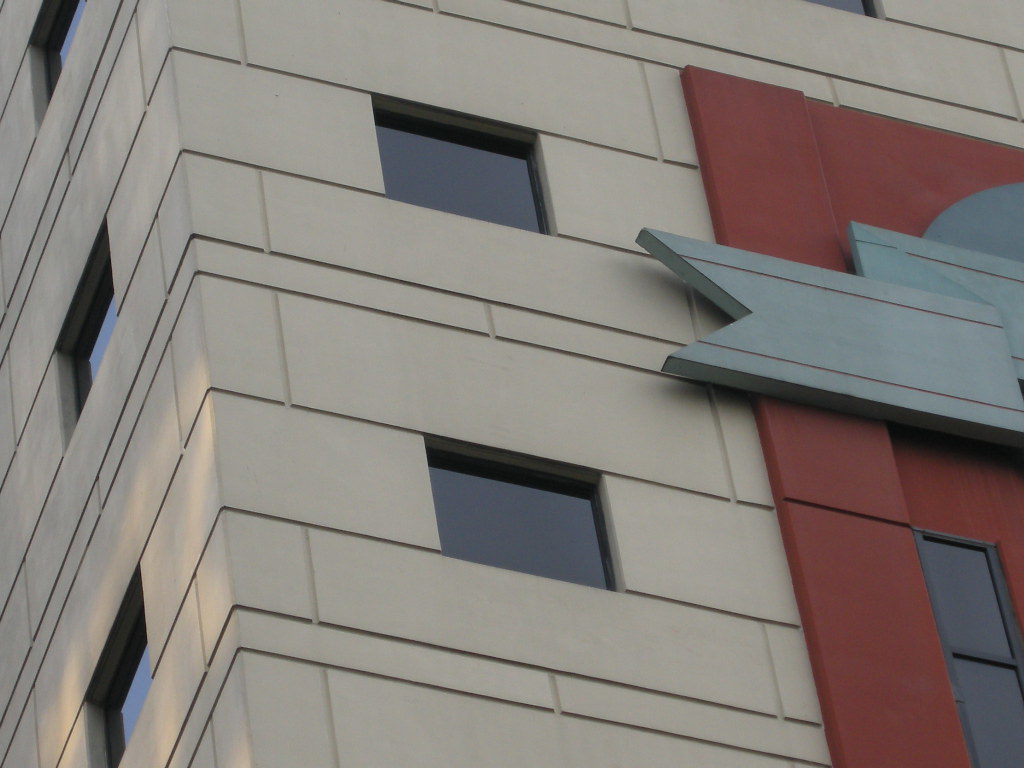
Origins & Development
Alucobond falls into the category of aluminum composite panels (ACP) or sandwich panels. Alcan Composites & Alusuisse invented aluminum composites in 1964 and commercial production of Alucobond commenced in 1969, followed by Dibond in 1989.<2> ACPs are used in a variety of industries ranging from aerospace to construction. Perhaps the most well recognized structure using ACP is the Epcot Center’s Space Ship Earth built in 1982. However, it is the work of Richard Meier and I.M. Pei during the 1980s that brought Alucobond into the forefront as an architectural cladding material. Several different skin materials are available including aluminum, zinc, copper, titanium and stainless steel.
Manufacturing
The major aluminum raw ingredient, bauxite, is mined throughout the world with US sources coming from Georgia, Jamaica, and Haiti. Processing of the bauxite predominantly occurs near the ocean ports, like Corpus Christi, where the raw material is off loaded. Manufacturing starts from either solid blocks of aluminum made into coil sheets or directly from pre-manufactured coil sheets. Assembly occurs along a continuous operating line that bonds the weather (exterior) and interior faces to the core, cuts the panel to length, and produces special shapes as needed.
Aluminum Composite Panels (ACP) are high-performance wall cladding products typically consisting of two sheets of nominal 0.020″ (0.50 mm) aluminum permanently bonded to an extruded thermoplastic core (polyethylene). Assemblies in the mid-1980s would often consist of curtain wall sub-components with sheets of aluminum on the exterior and insulation placed behind the aluminum sheets. (See fig)
ACP can be roll formed to curve configurations for column covers, architectural bullnoses, radius-building corners and other applications requiring radius forming. This process can be accomplished with a “pyramid” roll forming machine, which consists of three motor-driven adjustable rollers. You can successfully roll form ACP using machines with minimum 2 1/2″ (64 mm) diameter rolls. The operator normally makes multiple passes of the panel through the rollers to gradually obtain the desired radius. <3>
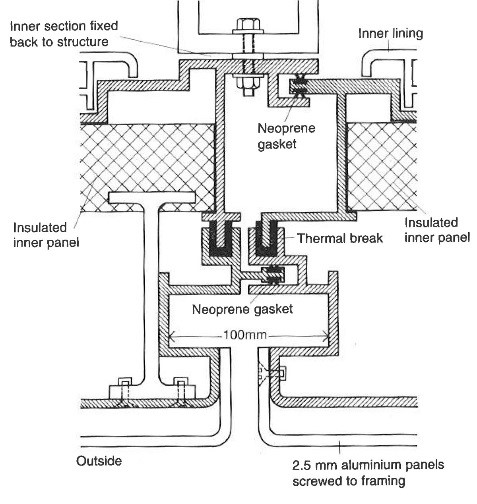
Use & Methods of Installation
Post Modern assemblies generally assumed water would get behind the face aluminum panel and need a weep path to exit the system. Air gaps were incorporated to induce drying and allow for weeping via gravity. Wind loads were accommodated through additional brackets, or stiffeners, set behind the face panel and connected to sub-framing. Much of the technology was based on curtain wall knowledge.
The panel systems could often be complex in the attachment to the structure, but the face panels were very similar to panels of today.
Conservation
Deterioration mechanism are generally associated with the system assembly and rarely are there failures in individual panels beyond cosmetic damages to the face aluminum including fading colors, scratches, and impact damages. More often incorrect fasteners were used that create galvanic reaction between the fastener and aluminum panel or inadequate fasteners were used to accommodate structural loads. The lack of design for thermal movement between panels, over the height and length of the panel façade, or along edge interfaces with sealants are also key areas of assembly failures.
Fortunately manufactures of Alucobond, or other aluminum composite panels, are still manufacturing the panel and components making in-kind replacement a viable conservation option. Inadequate structural systems can be reinforced through disassembly of the ACP for access to the structural support. Laser scanning technology has greatly enhanced the accuracy of recording existing conditions and is critical in reproducing replacement panels. Although labor intensive, most of the systems were attached using stainless steel fasteners. Like modern curtain walls, sealant and gaskets will be removed during disassembly and require reinstallation.
Repainting or repairing surface defects is feasible but the results generally do not achieve the same quality of finish as the factory applied coating process. And as with all repainting projects, surface preparation is critical to the long-term success of the project.
Loss of original Post Modern aluminum composite panel systems can be reduced through an increasing interest and research into the original design intent and assembly techniques. ACP were incorporated into Post modern structures because of the simplicity to create the curved forms and for rapid pace of construction. The systems are an important part of understanding Post Modernism and worthy of Conservation.
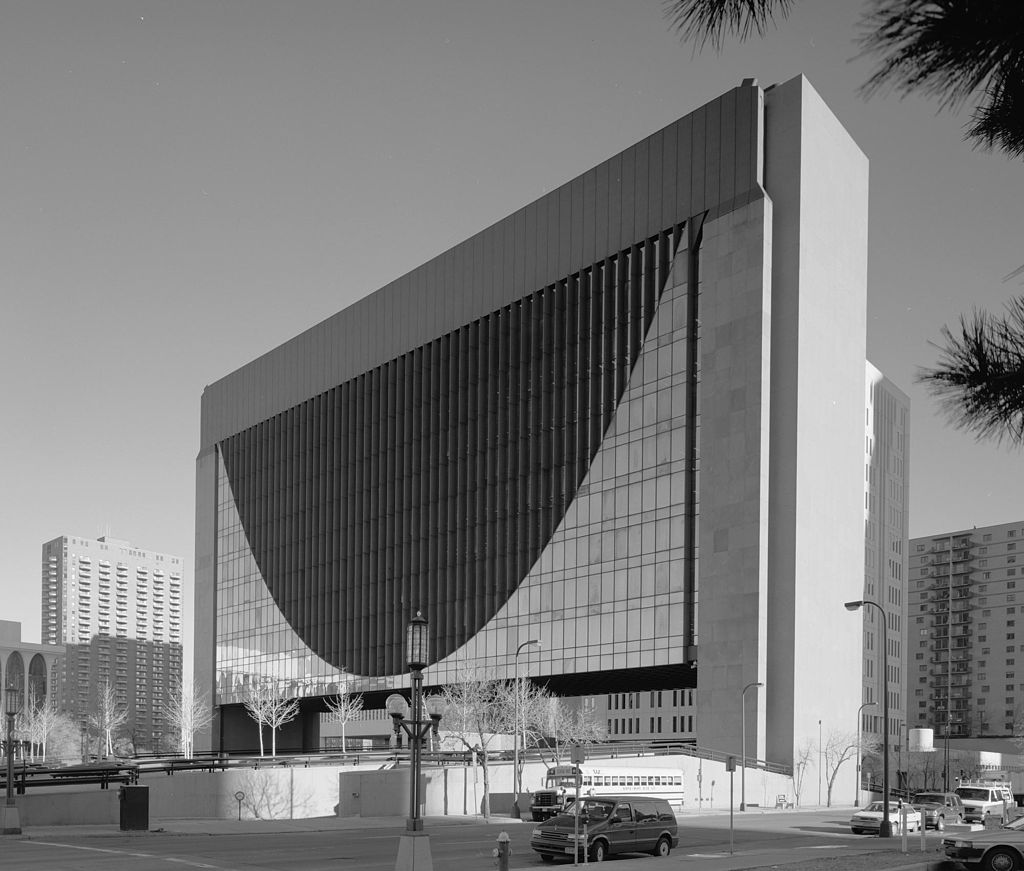
Marquette Plaza (historic photograph)
Written by Peter Meijer, AIA, NCARB, Principal
Advances in science and material properties have always played a role in the development of building products. Postmodernism fueled the advent of several new building materials including Glass Reinforced Polyester (James Stirling, Olivetti Training Center, c.1972), Insulated Exterior Metal Panel Systems (Richard Meier, Bronx Development Center, c.1979), Dupont’s Fabric Tensile Structures (University of Florida Gainesville, O’Connell Center, c.1980), polycarbonate sheets (Kalwall, et.al.), pre-fabricated brick panel systems, and many other new construction technologies.
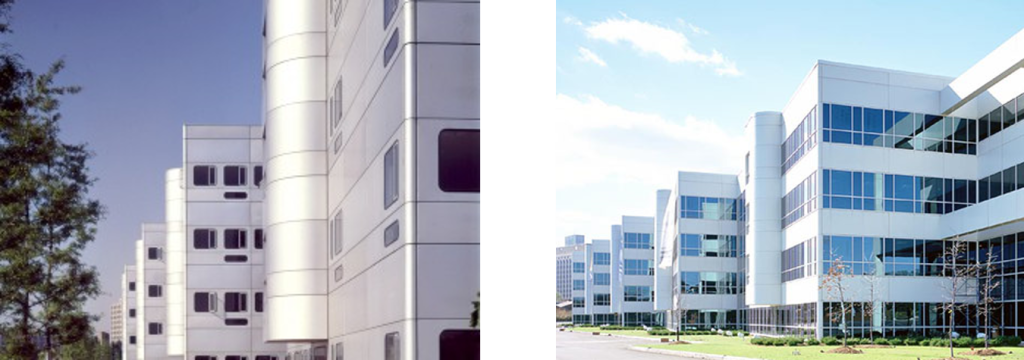
Richard Meier, Bronx Development Center, 1977
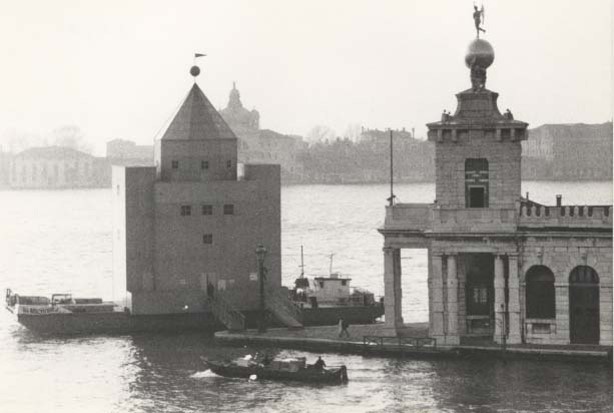
Aldo Rossi, Theatro Delmondo, Venice 1982
Rehabilitation and Postmodern materials
The rehabilitation of Postmodern materials is compounded by the lack of physical or chemical stability in the original product (e.g. color fading or material breakdown by UV light); changing urban context and surrounding development; inadequate original construction means and methods, and lack of precedence – Postmodern buildings are just now reaching the end of their design life-cycle. Proposals to improve envelope performance are challenged in finding products that will improve performance and retain the aesthetics of a Postmodern building. Given these challenges, is the proper repair, rehabilitation, or conservation of Postmodern structures to retain the appearance of insubstantial material installed incorrectly? Or should any new work, often entailing proposals for replacing the building facades, to discount the design appearance and fix the problems regardless of the impact.
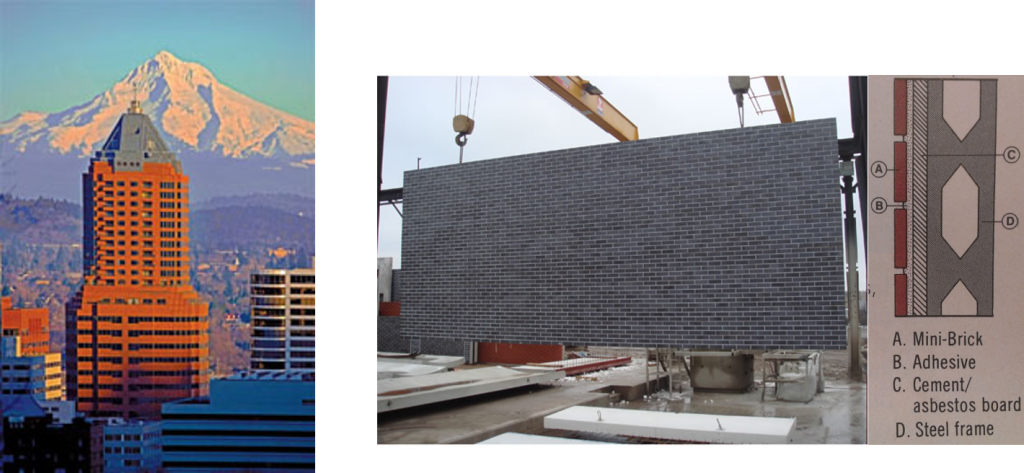
ZGF, Koin Center, 1982
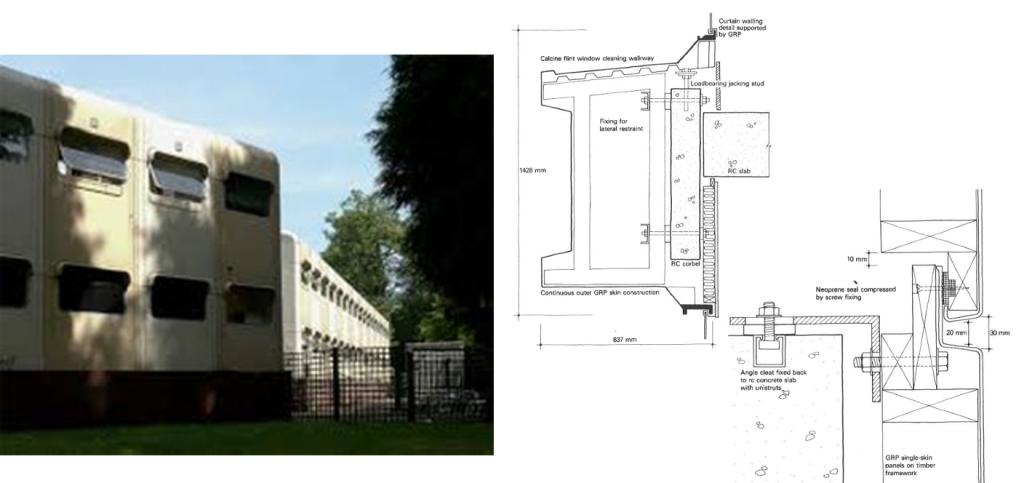
James Stirling, Olivetti Training Center, 1972
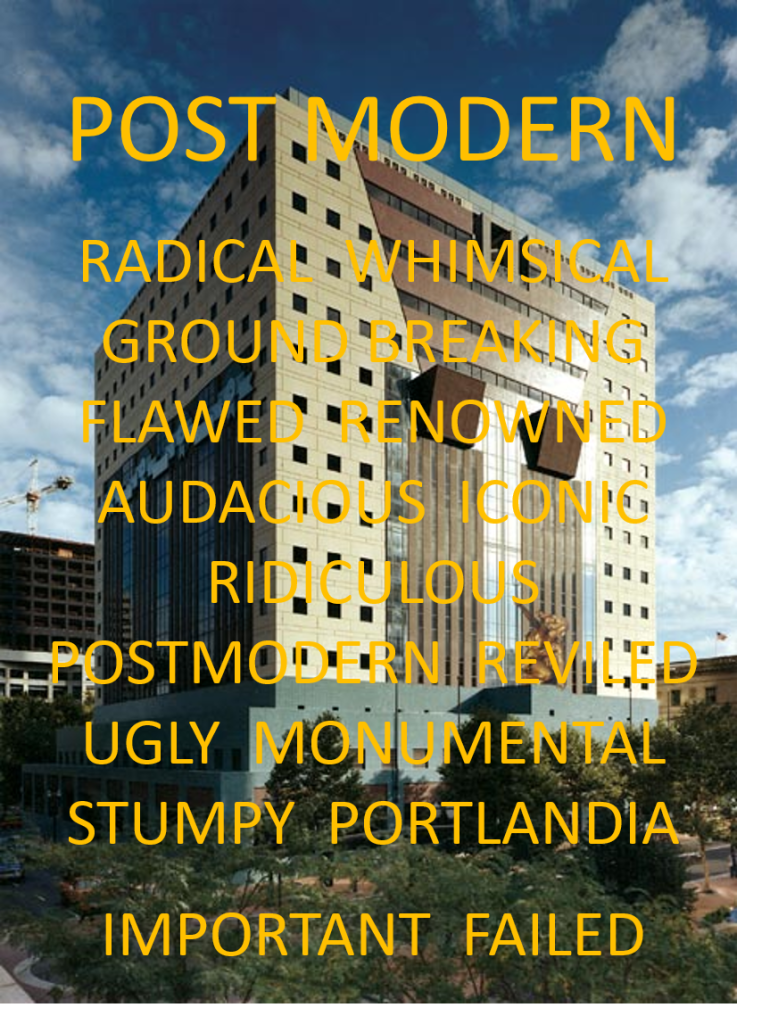
Portland Building
Written by Peter Meijer, AIA, NCARB / Principal
First presented at RCI 2015 Symposium on Building Envelope Technology, Nashville, TN
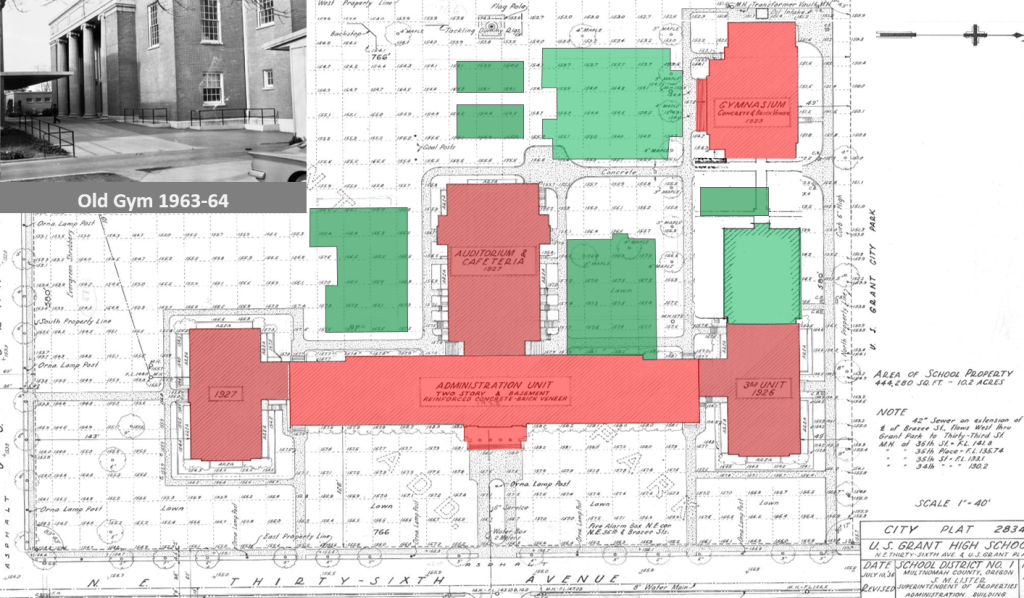
Background
When it was completed, Grant High School was typical of the high schools constructed by Portland Public Schools in the pre-World War II era. In addition to being an extensible school, including educational buildings constructed between 1923 and 1970, the school was also reflective of fire-proof construction through its use of a reinforced concrete structure with brick in-fill. (Portland Public Schools, Historic Building Assessment, Entrix, October 2009)
Over the last fifteen years, Portland Public Schools (PPS) noted an accelerated degree of masonry face spalling on the original 1923 main building and 1923 Old Gym particularly when adjacent to concentrated sources of surface water. Other areas of spalling were not as obvious including protected wall surfaces. The masonry spalling was not occurring on later additions including the north wing (circa 1925), south wing (circa 1927), and auditorium building (circa 1927). Upon closer visual examination, it was observed that individual units were failing in isolated protected areas of the wall surface. Failures in such areas could not be accounted for under direct correlation of heavy water intrusion and typical failure mechanisms.
The failure of the brick was potentially due to a number of separate or cumulative conditions including 1) excessive water uptake by the brick; 2) sub-fluorescence expansion of salts in the masonry, 3) freeze thaw; 4) low quality of the original 1923 brick; and 5) the application of surface sealers preventing water migrating to the exterior surface.
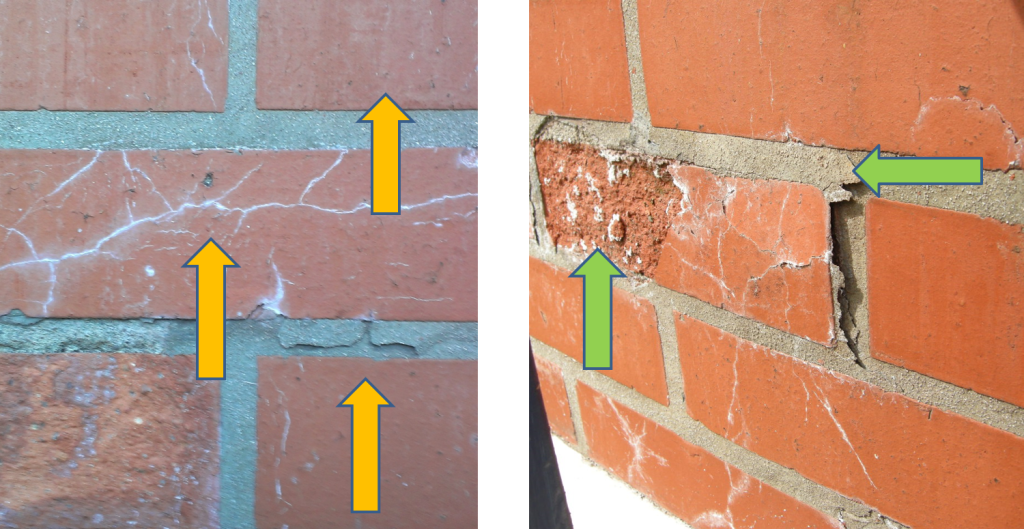
Field Investigation
In order to determine if the damage to the masonry was deeper than the surface, several wall-lets, an invasive exterior wall opening, were performed confirming the assembly of a multi-wythe masonry wall constructed in a typical fully bedded bond course with interlocking headers and no cavities between the first three brick courses. Hooked shaped, 3/32” gage, steel wire masonry ties in alternating courses and approximately twelve inches (12”) on center ties were found to be in good condition with no deterioration. The absence of corrosion on the in place brick wire ties indicated that little moisture was present inside the multi-wythe wall.
As a result of the hypothesis and field observations, it was prudent to conduct a series of lab tests to the brick, mortar, and patch materials to assist in the determination of 1) the quality of the brick; 2) the physical composition of the brick; 3) the quantity of naturally occurring compounds in the masonry and mortar, particularly salts in the masonry; and 4) the quality of the mortar. The findings would help narrow the potential cause of the spalling and lead to a more focused repair and maintenance process. Bricks were removed for testing of Initial Rate of Absorption (IRA – a test for susceptibility to water saturation) freeze thaw testing, and petrographic analysis, a way to determine the inherent properties of the clay and manufacturing process. Both pointing and bedding mortar samples, as well as, the previous patching material were removed and also tested. To rule out damage caused by maintenance procedures, faces of the brick material were sent to determine if sealants were used on the brick and, if present, determine the sealant chemical makeup. The presence of a surface coating may lead to retention of water within the brick and thus prevent natural capillary flow, natural drying, and water evaporation.
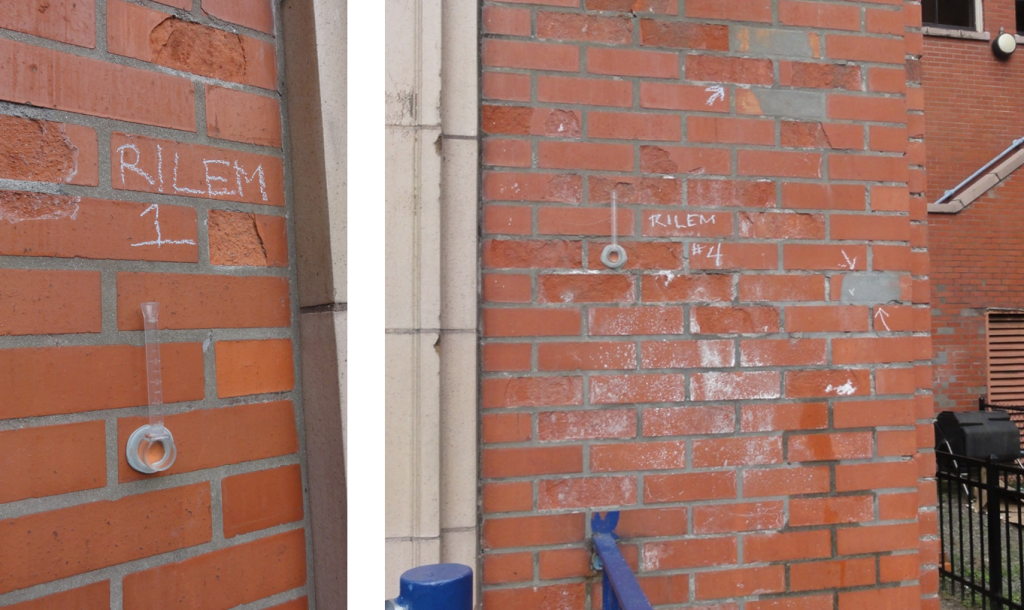
Testing & Results
Samples sent to the lab for coating assessment were analyzed via episcopic light microscopy, and Fourier- Transform Infrared Spectroscopy (FTIR) per ASTM D1245 and ASTM E1252. The results found no hydrocarbon or organic formulations used on the surface of the brick refuting the hypothesis of a surface sealer.
Following modified ASTM standards, a 24-hr immersion and 5-hr boil absorption test on the brick were performed. The brick have a very low percent of total absorption at 9.5% for the 5-hr boil and 7.5% for the 24-hr test. The maximum saturation coefficient is 0.79 which is 0.01 over the maximum requirements for Severe Weathering bricks recommended for Portland climate (ASTM C216-07a Table 1). The Initial Rate of Absorption (IRA) is 5.7g/min/30in2 which equates to a very low suction brick or brick with low initial rates of absorption. The freeze thaw durability tests resulted in passing performance. All of these tests refuted the hypothesis that freezing temperatures were the cause of masonry spalling.
A brick material analysis was performed in general conformance with ASTM C856, ASTM C1324 (masonry mortar) and included petrographic analysis, chemical analyses, x-ray diffraction and thermogravimetric analysis. Samples were analyzed under a polarized light microscope for information such as materials ratio and presence or absence of different deterioration mechanisms. These tests were used to assess the overall quality of material, presence of inherent salts, excessive retempering, cracking, ettringite formation, and potential alkali‐silica reactivity.
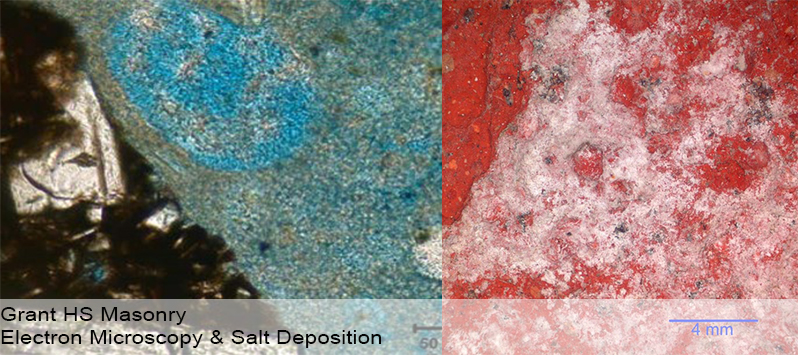
The Petrographic Characterization resulted in the most unusual findings and the most relevant results related to the observed failures. The polarized light microscope indicated carbonate based salt crystals seeping into the masonry from the mortar. No sulfate based salts, typically associated with the clays used for making brick, were present. Furthermore the inherent properties of the brick showed very small rounded voids and interconnected planer voids. Planner voids result from poor compaction during the raw clay extrusion process prior to firing.
Performance of brick in the field is a result of both material properties and resistance to micro-climates within the brick’s capillary void structure which cannot be repeated in the lab. Studies have shown a connection between small voids in the material property and susceptibility to longer water retention near the surface. With natural absorption properties, the brick is taking in a small quantity of water in very small pores. 24-hour immersion results are very low (7.5%). Publication of more in-depth studies correlates maximum saturation values for brick with low 24-hour immersion values. The effect of low immersion values and small quantities of absorbed water may increase the susceptibility in brick with small pore structure to freeze thaw failure.
The presence of salt migration out of the mortar and into the brick, plus small pore structure and low immersion values, combining with a cleavage plane resulting from manufacturing are contributing to the Grant High School brick spalls. Brick with smaller pores are less capable of absorbing the expansive forces of freezing water and drying salts. Interlaced pores creating linear plains parallel with the face of the brick create stress failure points resulting in surface spalling. Since the characteristics of the brick resulted from the firing and manufacturing process, the brick will remain susceptible to the failure mechanisms.
Conclusion
Field observations of masonry failures generally correspond with known failure mechanisms. However, it is not unusual that further analysis is necessary to confirm in-field performance and that typical laboratory test results are in conflict with in-situ performance.
The best corrective action is to minimize the amount of surface water and proper mortar joints and mortar composition. Additional spalls are likely to occur in the future due to the accumulation of expansive forces over a long period of time. Replacement of the spalled bricks is recommended over further patching. Leaving spalled brick in place will continue to worsen the condition over time and affect adjacent brick.

Written by Peter Meijer, AIA, NCARB, Principal
Post Modernism, a style of architecture beginning in 1965 with the publication of Robert Venturi’s Complexity and Contradiction in Architecture and extending to 1989, has always elicited great public debate on the architectural merits of its built works perhaps best exemplified in the controversy over one of the most iconic Post Modern buildings, Michael Graves’ Public Service Building (aka the Portland Building).
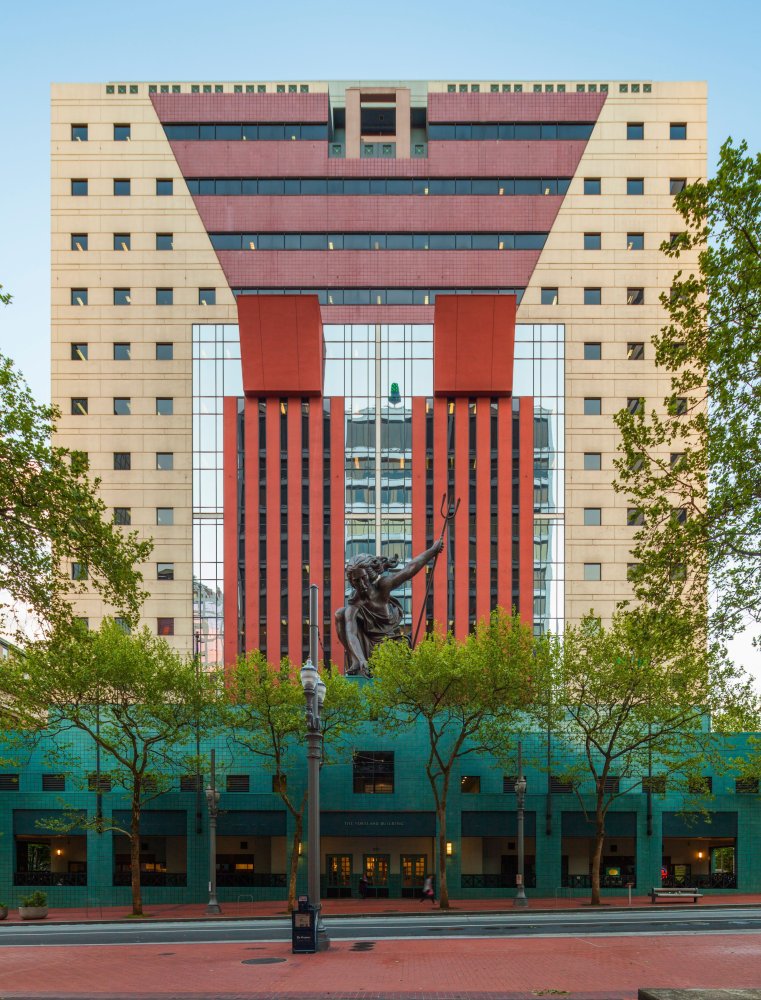
Whether or not Post Modern architecture is considered merely flamboyant superficial decoration or serious building design and genuine work is greatly debated. The debate, beginning a mere thirty years after the apex of the style, has arrived sooner than expected and focuses on the distinction between design and architecture. Whether or not the materials and assemblies used to construct the buildings are impermanent remain to be assessed, understood, and judged over a longer duration of time. Therefore, are material conservators and preservation technologists ready (and willing) to contribute a scientific approach and unbiased assessment to a controversial debate over a design style?
Post Modern design was broadly practiced in both the United States and internationally. Large and small firms were attracted to the stylistic incorporation of classical western design vocabulary in stark juxtaposition against the plain, unadorned, square box that many argued architecture had become. Design magazines published examples of Post Modern buildings ranging from the academic and scholar approach by architects like the Italian Aldo Rossi to the flamboyant American style creator Philip Johnson, as well as, buildings by architects only known on local and regional levels.
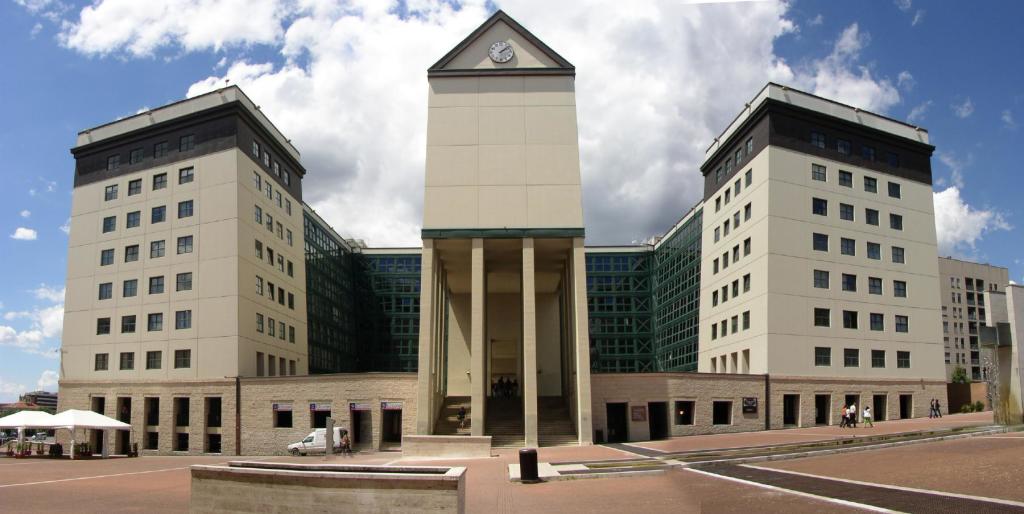
Architects, engineers, and material suppliers were pushing new materials and innovative construction technologies as a way to create Post Modern design elements. Continuous innovation in building skins reintroduced porcelain enamel panels, a product brought by Lustron to the building industry during the housing boom following World War II. New skins made from Glass Fibre Resin (GFR) capable of being molded in classical curves and ornamental shapes favored by Post Modern design were created. Innovations in brick technology including large scale brick panels made from a single wythe of masonry to panels whose outer face was only one half inch of masonry, or thin bricks. Improvements in resins created new wood or simulated wood products and adhesives for mounting faux finishes to structural systems. Perhaps one of the more ubiquitous new materials used in the creation of Post Modern architecture was the faux stucco product Dryvit, and Exterior Finish Insulation System (EIFS). Like porcelain enamel panels, EIFS were introduced as insulated wall assemblies as a means to improve energy performance during the world’s energy crisis of the 1970s.
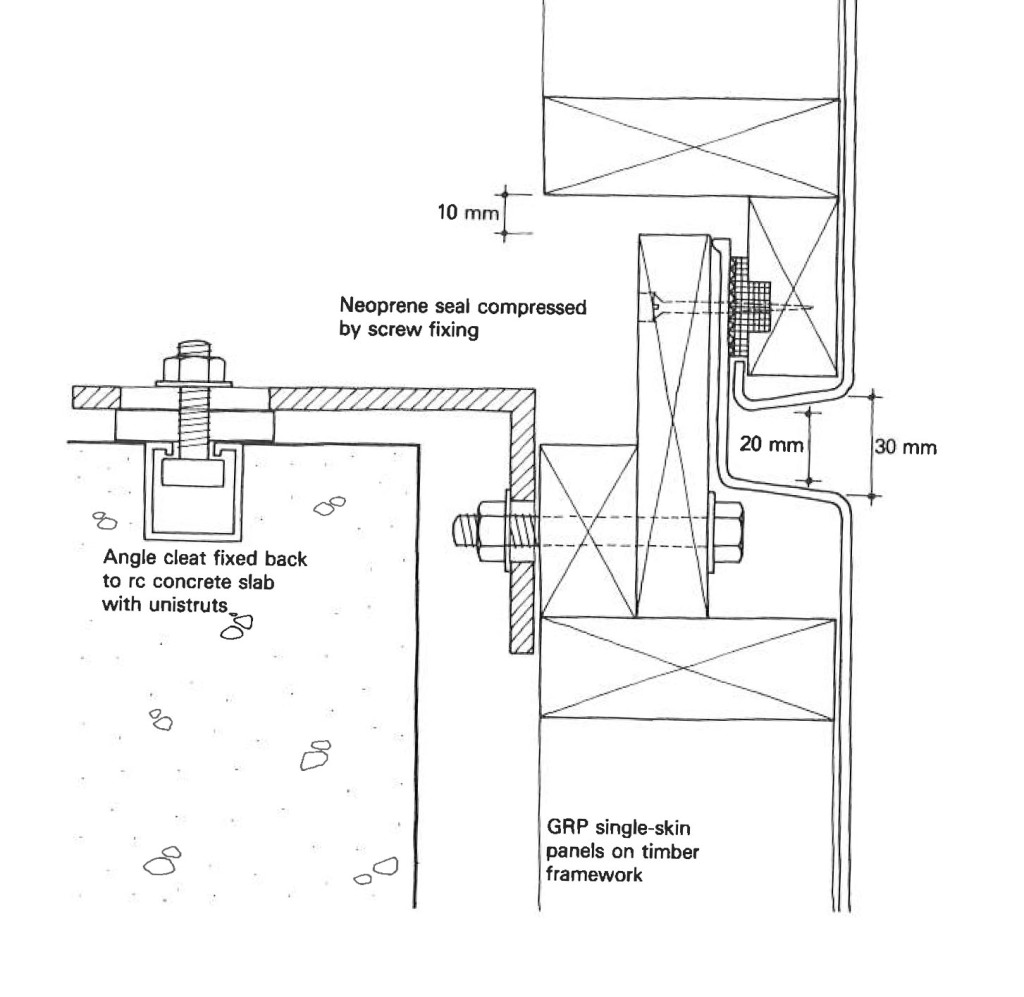
As Post Modern buildings reach thirty and fifty years, systems and products are aging and, like all older buildings, significant investments or improvements to infrastructure systems are often needed. Compared to more recent material innovations, Post Modern building performance levels are low and some of the innovative materials resulted in long-term material failures. As it is with any building skin, often the deficiencies of one material are in combination with more robust materials or the failing components are critical to the character defining features of the Post Modern design. And when material failure is coupled to design aesthetics and those aesthetics do not offer universal appeal, questions arise as to the merits of retaining the component. But should subjective opinions about design, a very personal matter compared to one’s appreciation of art, drive decisions to preserve or demolish a building? And when the building carries international recognition as a work of architecture, or as a work that defines the Post Modernism, should more resources be given to its preservation? Does the inherent impermanence of the original materials justify an approach of non-preservation as preservation? Many Post Modern buildings incorporate systems or components that are neither produced nor currently assembled in similar manners due to improvements in technology and building envelope science. Therefore, the process and method of building envelope repair could dramatically impact the exterior character of Post Modern structures.
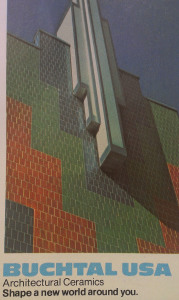
Is the proper approach to retain the essence of criticism towards Post Modernism by preserving the appearance of insubstantial material installed incorrectly? Proposals to improve envelope performance of both the individual components and building systems are challenged in finding products that will both improve performance and retain the aesthetics of a Post Modern building. Like previous building styles and periods, the preservation of character defining elements that were originally inadequately or incorrectly produced or assembled has always been a source of preservation controversy. In preservation and the undersized windows of the Portland Building are defining elements of the Post Modern design. The preservation community should be prepared to participate in discussing the merits of Post Modernism. The conversation has begun.
Written by Peter Meijer AIA, NCARB, Principal.
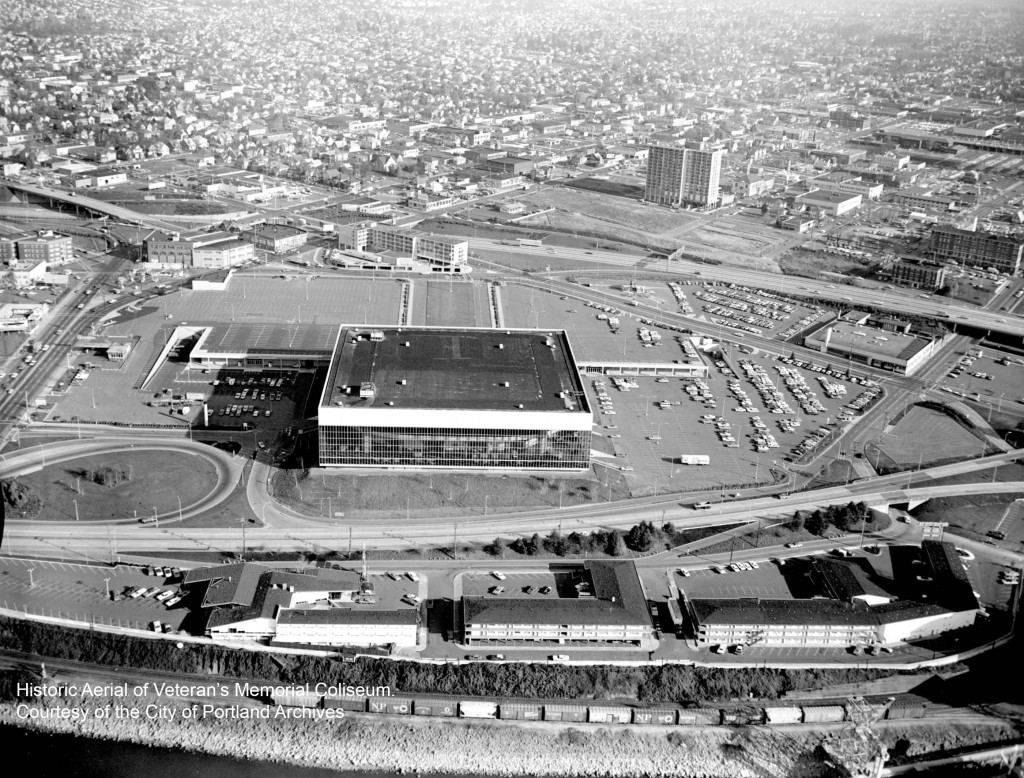 Presently, the City of Portland awarded a contract for Spectator Facilities Construction Project Management Services for a yet unnamed Veterans Memorial Coliseum project. The city is preparing for potential renovation scenarios. The uncertain future of the Coliseum feels like déjà vu.
Presently, the City of Portland awarded a contract for Spectator Facilities Construction Project Management Services for a yet unnamed Veterans Memorial Coliseum project. The city is preparing for potential renovation scenarios. The uncertain future of the Coliseum feels like déjà vu.
Portland’s Veterans Memorial Coliseum, designed by Skidmore, Owings & Merrill (SOM) and built between 1960 and 1961, is a premier jewel of International Style modernism in the city. The structure consists of glass and aluminum, a non-load-bearing curtain wall cube with a central ovular concrete seating area. It is a true engineering and architectural masterpiece that offers uninterrupted panoramic views of Portland from the seating area. The Veterans Memorial Coliseum is also a war memorial, featuring exterior sunken black granite walls inscribed with the names of veterans in gold paint.
At its completion it was the largest multipurpose facility in the Pacific Northwest. And a significant structure within the larger urban planning Rose Quarter Development project. In 2009 the city of Portland proposed to demolish the Coliseum to make way for a new sports facility. The greater community of Portland, including architectural preservationists and historians, successfully applied for National Register of Historic Places status for the building. In 2011 it was placed in the National Register.
Portland’s Veterans Memorial Coliseum is a phenomenal renovation opportunity from both historic and economic perspectives. 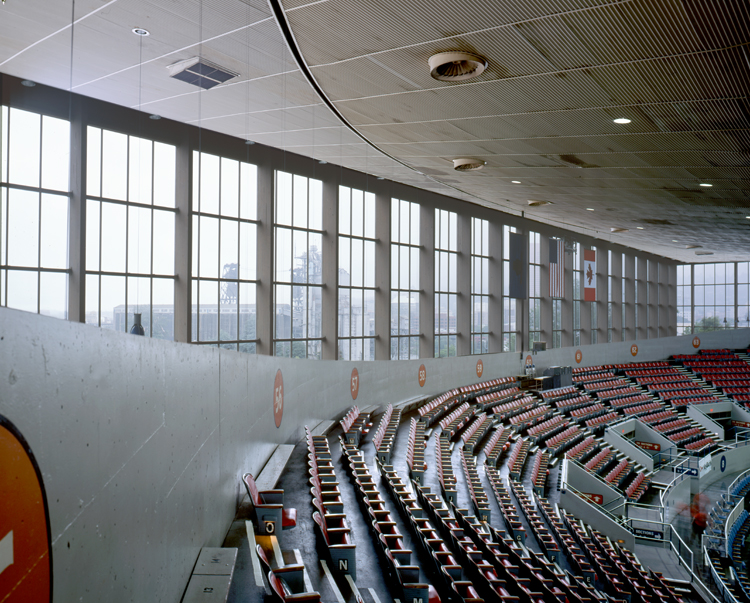
Despite being listed in the National Register, built during an era of urban and planning reform that advocated for the latest in building technologies, and designed by one of our countries leading modernist firms, many challenge its architectural value. The Coliseum shows the remarkable and collaborative approach towards design and construction by SOM. It is also the only arena world-wide with a 360-degree panoramic view from the seating area. Consider the inability to experience this modern architectural marvel and war memorial firsthand. Simply put, the demolition of the Veterans Memorial Coliseum would be a loss to the city.
Concerns regarding its deferred maintenance and historic materials are often attached to the illogical demolition conclusion because the building does not meet specific 2014 building codes. It is possible to integrate new building technologies while retaining the building’s exterior and interior character defining features. Unfortunately, significant modernist architecture designed by influential architects in the 1950s-1970s have not been regarded with proper facility maintenance. Deferred maintenance has its price. Regardless of building age, if a structure is not properly maintained it will fall into disrepair. Thankfully, Portland has a robust AEC industry dedicated to solving design challenges.
As a city, Portland boast’s its commitment to living green and investing in sustainable practices throughout the greater community. The renovation of the Veterans Memorial Coliseum is exactly the type of project that would highlight our city’s commitment to sustainability. There is no greener option than renovating and reusing existing architectural resources. This renovation would also economically benefit the city by boosting investment around the Rose Quarter area. Potentially extending and overlapping with the renewed development interest in the Lloyd District. Portland could have two premier sports facilities, doubling the city’s ability to provide world-class sports and entertainment events. It is a renovation project with long term urban renewal benefits. 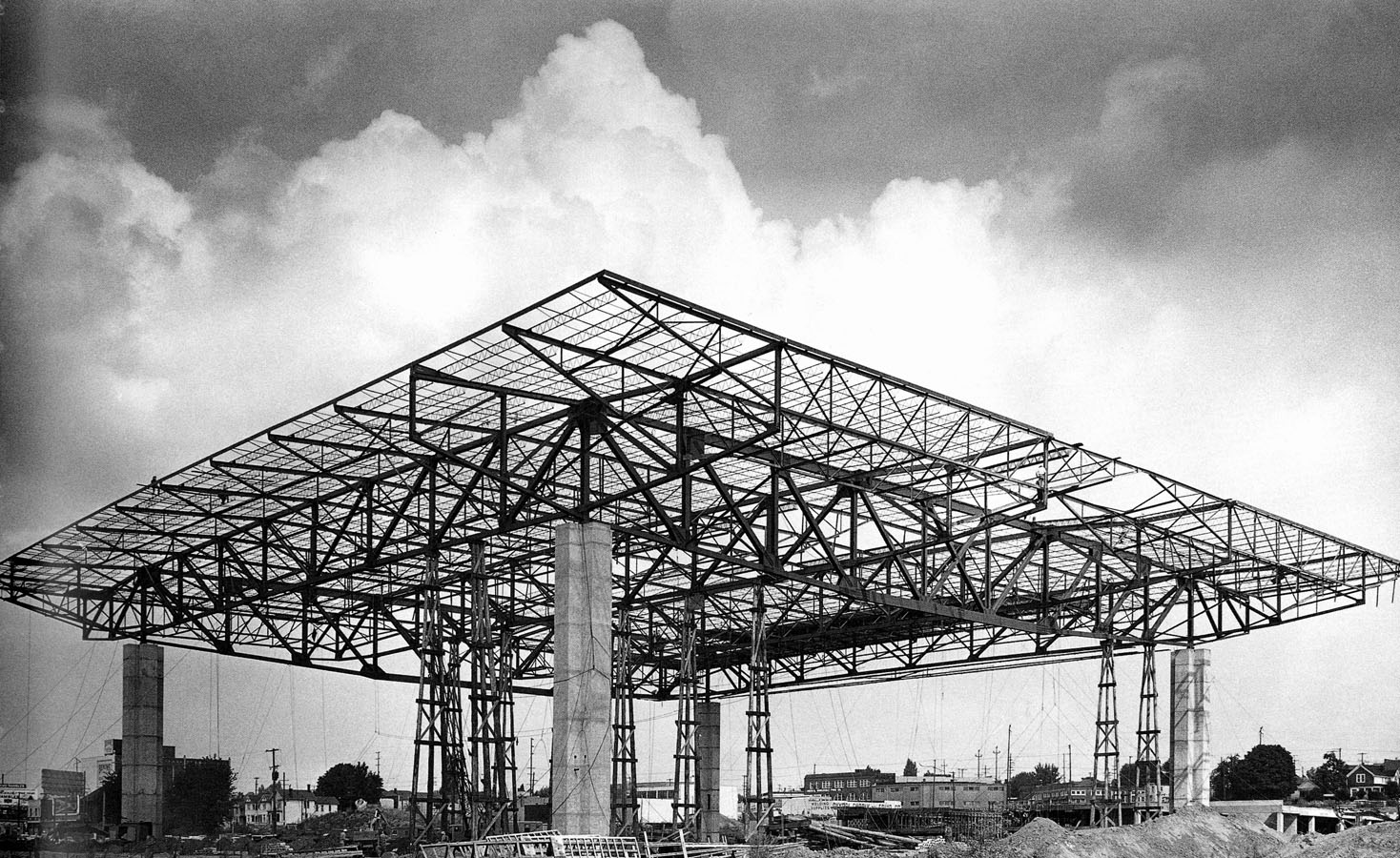
Veterans Memorial Coliseum is an internationally recognized architectural masterpiece. Its architectural legacy is deeply intertwined within Portland’s socio-economic and cultural heritages. Portland must learn from the recent demolitions of modernist architectural marvels like Prentice Women’s Hospital, several Paul Rudolph buildings, and the forthcoming Astrodome. Threats to our modern architecture is a threat to our architectural heritage. It is time to celebrate the last fifty years of Portland’s international jewel with a thoughtful renovation that looks ahead to the city’s next fifty years of architectural history.
Written by Kate Kearney, Marketing Coordinator
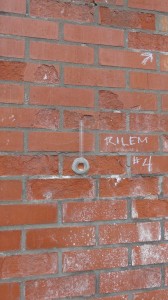 Are masonry sealers necessary on historic multi-wythe exterior walls? In general, likely not. Traditional exterior mass unit masonry walls, 3 to 4 wythes thick, leak. But rarely does the amount of water intrusion cause damage to the masonry, the masonry ties, or the interior finishes. Why wouldn’t a sealer be effective for these older walls?
Are masonry sealers necessary on historic multi-wythe exterior walls? In general, likely not. Traditional exterior mass unit masonry walls, 3 to 4 wythes thick, leak. But rarely does the amount of water intrusion cause damage to the masonry, the masonry ties, or the interior finishes. Why wouldn’t a sealer be effective for these older walls?
Traditional means and methods of construction multi-wythe walls consist of course work bonded and tied together with header courses, row-lock courses, hidden headers, and set in full beds and back beds of mortar. There is no direct pathway for water intrusion following the mortar beds. And most sealers do not bridge bond line cracks between the masonry unit and mortar bed.
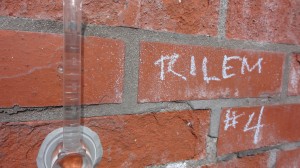 The porosity and absorption rates of older masonry are often exaggerated because of the brick appearance. Many older masonry units show the results of imperfect firing techniques. It is not unusual to see older masonry with vertical and horizontal cracks due to low firing temperatures or impurities in the original clay mix. The surface cracks may lead to higher rates of absorption around the crack but rarely increase the overall absorption or alter the overall characteristics of the masonry. Masonry sealers will not bridge these firing cracks.
The porosity and absorption rates of older masonry are often exaggerated because of the brick appearance. Many older masonry units show the results of imperfect firing techniques. It is not unusual to see older masonry with vertical and horizontal cracks due to low firing temperatures or impurities in the original clay mix. The surface cracks may lead to higher rates of absorption around the crack but rarely increase the overall absorption or alter the overall characteristics of the masonry. Masonry sealers will not bridge these firing cracks.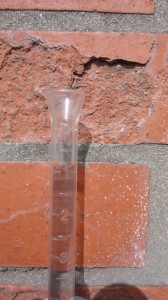
If older walls exhibit a level of moisture intrusion, the drying dynamics have traditionally been from warm interior side and evaporation towards the exterior. Interior insulation techniques will result in a colder exterior wall that will stay wetter longer. Masonry sealers can impede the natural drying process and movement of water towards the exterior. Vapor permeable “breathable” sealers limit the outward movement of water by natural capillary action impeding the drying dynamics. The major concern with applying sealers to masonry is related to drying.
The Brick Industry Association, Technical Note No. 6A states: “Application of a water repellent coating is not necessary to achieve water resistance in brickwork subjected to normal exposures where proper material selection, detailing, construction and maintenance have been executed.” BIA goes further: “Application is not recommended on newly constructed brick veneer or cavity walls…” There is little to no research showing the effectiveness of sealers on reducing water intrusion in masonry walls. Sealers primarily reduce the initial rate of absorption at the brick surface. Sealers also cannot change water intrusion due to poor construction techniques. Wind driven rain is rarely impeded by sealer applications. “the use of water-repellent coatings to eliminate water penetration in a wall with existing defects can be futile.”
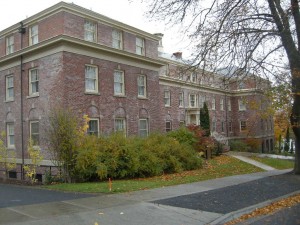 To control water intrusion and to increase performance of a masonry wall, it is much more effective to maintain mortar joints through re-pointing process, assure that mortar joints have no voids, replace brick with spalled faces, replace brick that are cracked the full depth, and repair bond line failures. The use of masonry sealers should be based on known research and field tested success and not chosen as a means to remedy poor construction methods.
To control water intrusion and to increase performance of a masonry wall, it is much more effective to maintain mortar joints through re-pointing process, assure that mortar joints have no voids, replace brick with spalled faces, replace brick that are cracked the full depth, and repair bond line failures. The use of masonry sealers should be based on known research and field tested success and not chosen as a means to remedy poor construction methods.
Written by Peter Meijer AIA, NCARB Principal
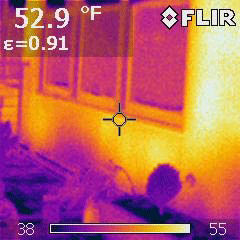
Visual observations are not sufficient to determine the cause of failures in masonry walls. However, visual observations, combined with technical knowledge, provide a good direction for further investigation. In the Pacific Northwest, with the predominance of rainy winter weather, the effect of moisture saturation on masonry walls is readily apparent. Moisture is the primary cause of masonry deterioration. Horizontal surfaces will accumulate organic growth, mortar and masonry surfaces show rain water runoff patterns, and any discontinuity in roof runoff systems quickly cause further deterioration to the masonry walls. Severe masonry deterioration does occur in the northwest but its occurrence is considerably less dramatic when compared to harsher winter climates in the Midwest and East. For instance, brick spalls due to freeze thaw effect are a rare occurrence in the northwest.
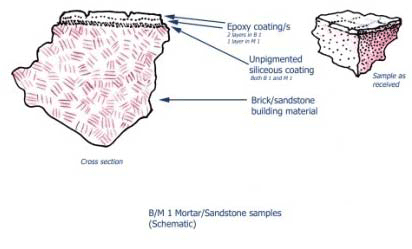 When severe deterioration of masonry walls is not a prevalent condition, what other non-visual processes are employed to determine the cause of deterioration? Two common techniques, well known to historic preservation professionals, are non-destructive testing (NDT) and material testing in the laboratory. NDE methods include RILEM tube water absorption tests, metal detector scanning, video scopes, infra-red photography, ultra sound testing, ground penetrating radar, and in some cases, x-ray diffraction. Common laboratory testing include petrographic examination, electron microscopy, and Fourier Transform Infrared (FTIR) methods.
When severe deterioration of masonry walls is not a prevalent condition, what other non-visual processes are employed to determine the cause of deterioration? Two common techniques, well known to historic preservation professionals, are non-destructive testing (NDT) and material testing in the laboratory. NDE methods include RILEM tube water absorption tests, metal detector scanning, video scopes, infra-red photography, ultra sound testing, ground penetrating radar, and in some cases, x-ray diffraction. Common laboratory testing include petrographic examination, electron microscopy, and Fourier Transform Infrared (FTIR) methods.
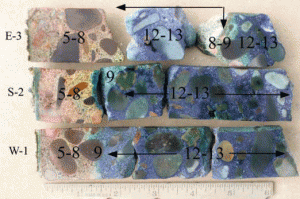 FTIR, when combined with the diagnostic RILEM tube field test, in particular is an effective evaluation to determine if masonry sealers have been applied to a wall surface impeding the capillary evaporation of trapped water. RILEM tests also provide an observation of a masonry wall’s initial rate of absorption under wind driven rain circumstances. Petrographic analysis of both masonry and mortars determines the material composition and will identify harmful natural elements and harmful additive elements like salts.
FTIR, when combined with the diagnostic RILEM tube field test, in particular is an effective evaluation to determine if masonry sealers have been applied to a wall surface impeding the capillary evaporation of trapped water. RILEM tests also provide an observation of a masonry wall’s initial rate of absorption under wind driven rain circumstances. Petrographic analysis of both masonry and mortars determines the material composition and will identify harmful natural elements and harmful additive elements like salts.
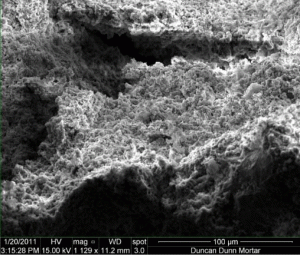 A common misconception in the northwest is that surface spalls are a result of freeze thaw cycles. Freeze thaw susceptibility can only be determined through laboratory testing. Visual observations are insufficient to conclude masonry spalls resulted from freeze thaw forces. Since freeze thaw tests are graded either pass or fail, further tests methods are typically required for additional diagnostic evaluation. More likely sources of surface spalls are hard Portland cement mortars which exceed the strength of the masonry, salts introduced into the masonry through incorrect material selection, or surface sealers impeding the evaporation of water and thus creating a saturated sub surface layer which will freeze. (It is important to distinguish that the masonry unit may not be susceptible to freeze thaw but rather the sealer creates a dam like effect inducing a layer of water subject to freezing)
A common misconception in the northwest is that surface spalls are a result of freeze thaw cycles. Freeze thaw susceptibility can only be determined through laboratory testing. Visual observations are insufficient to conclude masonry spalls resulted from freeze thaw forces. Since freeze thaw tests are graded either pass or fail, further tests methods are typically required for additional diagnostic evaluation. More likely sources of surface spalls are hard Portland cement mortars which exceed the strength of the masonry, salts introduced into the masonry through incorrect material selection, or surface sealers impeding the evaporation of water and thus creating a saturated sub surface layer which will freeze. (It is important to distinguish that the masonry unit may not be susceptible to freeze thaw but rather the sealer creates a dam like effect inducing a layer of water subject to freezing)
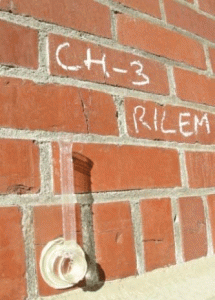 By combining visual observations with NDE and lab testing, most surface masonry deterioration can be determined and thereby implement proper repair, maintenance, and protection methods.
By combining visual observations with NDE and lab testing, most surface masonry deterioration can be determined and thereby implement proper repair, maintenance, and protection methods.
Written by Peter Meijer AIA, NCARB, Principal
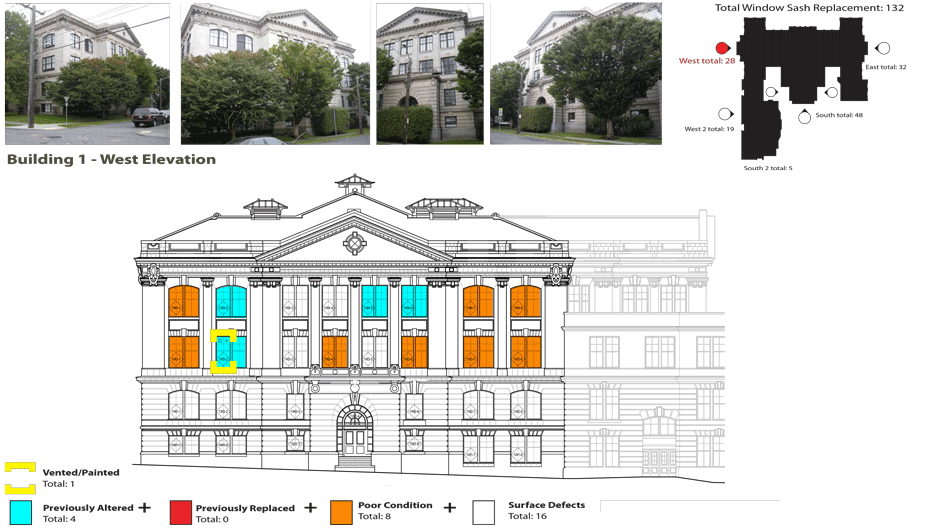 Our first choice, and ethical preference, is to retain historic wood windows. Repaired and maintained wood windows constructed of old growth lumber will outlast any modern alternative. We advocate strongly for a process and philosophy that seriously evaluates retaining original material. The best approach compares long-term costs, embodied energy, and cultural importance relative to the same criteria for new replacement material.
Our first choice, and ethical preference, is to retain historic wood windows. Repaired and maintained wood windows constructed of old growth lumber will outlast any modern alternative. We advocate strongly for a process and philosophy that seriously evaluates retaining original material. The best approach compares long-term costs, embodied energy, and cultural importance relative to the same criteria for new replacement material.
But what do you do when the comparative process favors new material and replacement becomes the option of choice? And how do you gain jurisdictional and historic approval for removing character defining features from a historic property? Correct research, documentation, presentation, and material selection are the key factors to successfully replace historic wood windows.
Lack of maintenance is rarely accepted as a justifiable rationale for window replacement. Arguments for window replacement based on peeling paint, surface tracking of the wood, and/or glazing putty failure are typically countered with comments that benign neglect is a conscious act and straight forward maintenance will reverse the deterioration and deficiencies noted. A better strategy is to base replacement rational on existing significant deficiencies that require financial investment and resource allocation to repair the deficiencies.
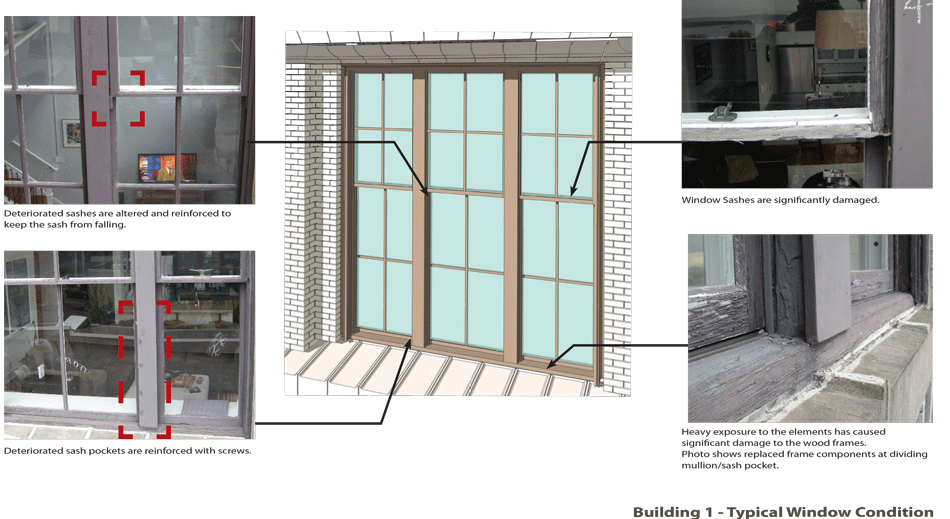 Most existing, older properties have had more than one owner. Research into original design documents, major rehabilitation projects, building permit requests, and other documents provide insight into processes that might have replaced original material. The removal and replacement of non-original material is justifiable and acceptable rationale.
Most existing, older properties have had more than one owner. Research into original design documents, major rehabilitation projects, building permit requests, and other documents provide insight into processes that might have replaced original material. The removal and replacement of non-original material is justifiable and acceptable rationale.
Documentation by means of an on-site, window by window survey is the only method that will yield quantifiable data regarding the physical condition of existing wood windows. The resulting comparative data is critical for structuring an argument in favor of replacement. The field observations also provide invaluable information pertaining to the means and methods of construction and conversely deconstructing, or removing, the windows. Understanding wood window construction is important to understanding how wood window fail. Source documents like the Association of Preservation Technology’s Window Rehabilitation Guide for Historic Buildings (1997) and the National Park Service Preservation Briefs: 9, The Repair of Historic Wooden Windows provide exploded diagrams of both wood window construction and typical failure locations. These locations generally include the sash mortise and tenon joints, the exterior stops, and horizontal rails. The field assessment will need to document the quantity, location, and extent of any failed components.
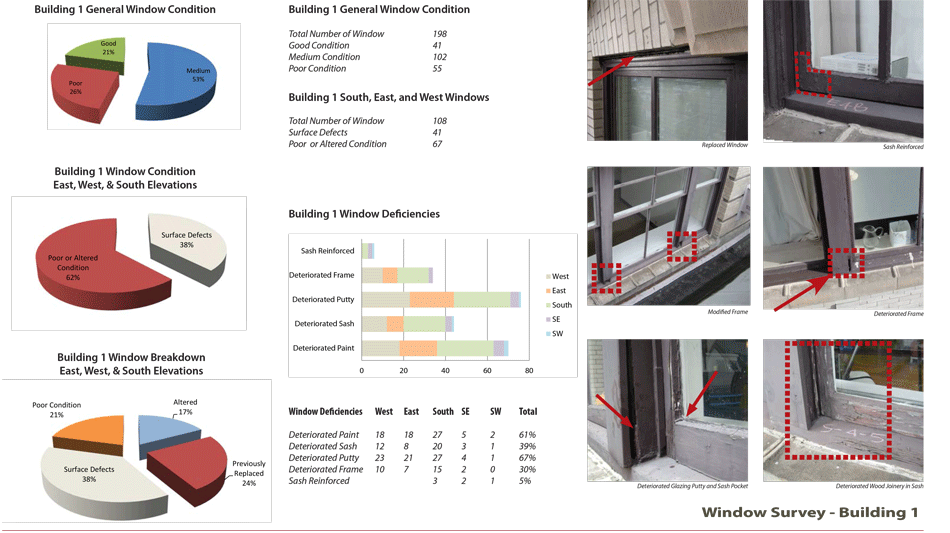 After a thorough evaluation and understanding of the existing wood windows, the next decision is to choose a replacement product. In-kind replacement,(i.e. wood window for wood window; true divided lites for true divided lites, matching pane divisions, etc.) is preferred. When the replacement window is virtually identical to the historic window, it is hard to say no. Absent exact replacement, the visual qualities exhibited by the cross section profiles, the sash height and width, and the proportion of wood to glazing, are the most important attributes to match. Appearance from the exterior will trump appearance from the interior during a historic review approval process.
After a thorough evaluation and understanding of the existing wood windows, the next decision is to choose a replacement product. In-kind replacement,(i.e. wood window for wood window; true divided lites for true divided lites, matching pane divisions, etc.) is preferred. When the replacement window is virtually identical to the historic window, it is hard to say no. Absent exact replacement, the visual qualities exhibited by the cross section profiles, the sash height and width, and the proportion of wood to glazing, are the most important attributes to match. Appearance from the exterior will trump appearance from the interior during a historic review approval process.
How the research findings, existing conditions, and replacement products are presented is fundamental to a successful request to replace historic wood windows. Agencies and commissions with jurisdictional review and approval authority require clear, methodical, and linear processes to understand the research, findings, and selection process. Collating the field data using charts and graphs, including graphic representation of previously altered windows, and defining the quantity of failed components will assist a decision in favor or replacement.
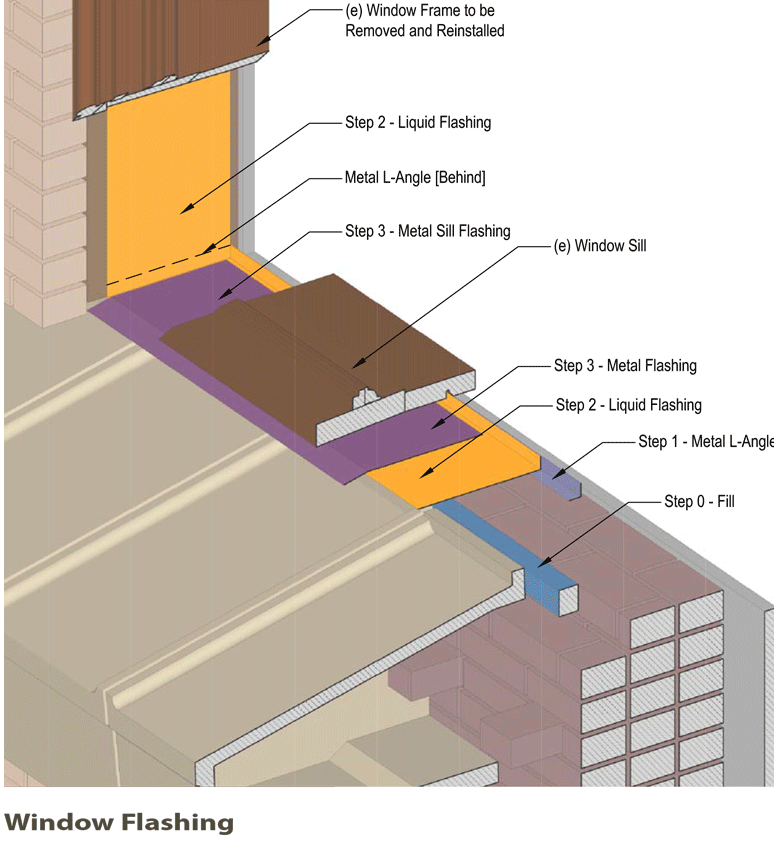 When an opportunity to retain original fabric/windows is available, the opportunity should be incorporated into the work. Even retaining as little as 20% of historic fabric will increase the likelihood of approval for replacement of the remaining components. The retention of historic fabric also allows successive generations to better understand the history and changes of an existing property.
When an opportunity to retain original fabric/windows is available, the opportunity should be incorporated into the work. Even retaining as little as 20% of historic fabric will increase the likelihood of approval for replacement of the remaining components. The retention of historic fabric also allows successive generations to better understand the history and changes of an existing property.
Written by Peter Meijer AIA, NCARB, Principal.